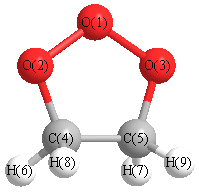Vibrational Frequencies calculated at QCISD(T)/cc-pVDZ
| Mode Number |
Symmetry |
Frequency
(cm-1) |
Scaled Frequency
(cm-1) |
IR Intensities
(km mol-1) |
Raman Act
(Å4/u) |
Dep P |
Dep U |
|---|
| 1 |
A' |
3151 |
3003 |
|
|
|
|
| 2 |
A' |
3068 |
2924 |
|
|
|
|
| 3 |
A' |
1505 |
1435 |
|
|
|
|
| 4 |
A' |
1339 |
1276 |
|
|
|
|
| 5 |
A' |
1236 |
1178 |
|
|
|
|
| 6 |
A' |
1019 |
971 |
|
|
|
|
| 7 |
A' |
944 |
899 |
|
|
|
|
| 8 |
A' |
858 |
817 |
|
|
|
|
| 9 |
A' |
835 |
796 |
|
|
|
|
| 10 |
A' |
689 |
657 |
|
|
|
|
| 11 |
A' |
408 |
389 |
|
|
|
|
| 12 |
A" |
3134 |
2987 |
|
|
|
|
| 13 |
A" |
3055 |
2912 |
|
|
|
|
| 14 |
A" |
1488 |
1418 |
|
|
|
|
| 15 |
A" |
1337 |
1275 |
|
|
|
|
| 16 |
A" |
1213 |
1156 |
|
|
|
|
| 17 |
A" |
1150 |
1096 |
|
|
|
|
| 18 |
A" |
1032 |
983 |
|
|
|
|
| 19 |
A" |
740 |
706 |
|
|
|
|
| 20 |
A" |
637 |
608 |
|
|
|
|
| 21 |
A" |
123 |
118 |
|
|
|
|
Unscaled Zero Point Vibrational Energy (zpe) 14479.5 cm
-1
Scaled (by 0.9531) Zero Point Vibrational Energy (zpe) 13800.4 cm
-1
See section
III.C.1 List or set vibrational scaling factors
to change the scale factors used here.
See section
III.C.2
Calculate a vibrational scaling factor for a given set of molecules
to determine the least squares best scaling factor.
